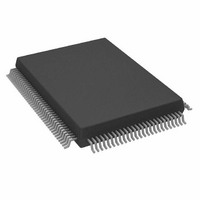AD9888KSZ-140 Analog Devices Inc, AD9888KSZ-140 Datasheet - Page 23

AD9888KSZ-140
Manufacturer Part Number
AD9888KSZ-140
Description
IC FLAT PANEL INTERFACE 128-MQFP
Manufacturer
Analog Devices Inc
Datasheet
1.AD9888KSZ-205.pdf
(32 pages)
Specifications of AD9888KSZ-140
Applications
Graphic Cards, VGA Interfaces
Interface
2-Wire Serial
Voltage - Supply
3 V ~ 3.6 V
Package / Case
128-MQFP, 128-PQFP
Mounting Type
Surface Mount
Supply Current
200mA
Power Dissipation Pd
850mW
Supply Voltage Range
3V To 3.6V, 2.2V To 3.6V
Digital Ic Case Style
MQFP
No. Of Pins
128
Operating Temperature Range
0°C To +70°C
Svhc
No SVHC
Number Of Elements
3
Resolution
8Bit
Sample Rate
140MSPS
Input Polarity
Bipolar
Input Type
Voltage
Rated Input Volt
±0.25/±0.5V
Differential Input
No
Power Supply Requirement
Single
Single Supply Voltage (typ)
3.3V
Single Supply Voltage (min)
3V
Single Supply Voltage (max)
3.6V
Dual Supply Voltage (typ)
Not RequiredV
Dual Supply Voltage (min)
Not RequiredV
Dual Supply Voltage (max)
Not RequiredV
Power Dissipation
1.05W
Differential Linearity Error
±1.35LSB
Integral Nonlinearity Error
±2.5LSB
Operating Temp Range
0C to 70C
Operating Temperature Classification
Commercial
Mounting
Surface Mount
Pin Count
128
Package Type
MQFP
Input Signal Type
Single-Ended
Interface Type
2-wire, Serial
Rohs Compliant
Yes
Lead Free Status / RoHS Status
Lead free / RoHS Compliant
Lead Free Status / RoHS Status
Lead free / RoHS Compliant, Lead free / RoHS Compliant
Available stocks
Company
Part Number
Manufacturer
Quantity
Price
Company:
Part Number:
AD9888KSZ-140
Manufacturer:
AD
Quantity:
217
Company:
Part Number:
AD9888KSZ-140
Manufacturer:
ADI
Quantity:
482
Company:
Part Number:
AD9888KSZ-140
Manufacturer:
Analog Devices Inc
Quantity:
10 000
REV. B
0F
0F
0F
10
3
A bit to indicate the polarity of the COAST signal that is
applied to the PLL COAST input.
Active LOW means that the clock generator will ignore
Hsync inputs when COAST is low, and continue
operating at the same nominal frequency until COAST
goes high.
Active High means that the clock generator will ignore
Hsync inputs when COAST is high, and continue
operating at the same nominal frequency until COAST
goes low.
This function needs to be used along with the COAST
polarity override bit (Bit 4).
The power-up default value is CSTPOL = 1.
2
This bit is used to either allow or disallow the low power
mode. The low power mode (seek mode) occurs when
there are no signals on any of the Sync inputs.
The default for this register is 1.
1
This bit is used to put the chip in power-down mode. In
this mode, the chip’s power dissipation is reduced to a
fraction of the typical power (see the Electrical Character-
istics table for exact power dissipation). When in power-
down, the HSOUT, VSOUT, DATACK, DATACK, and
all 48 of the data outputs are put into a high impedance
state. (Note: the SOGOUT output is not put into high
impedance.) Circuit blocks that continue to be active
during power-down include the voltage references, sync
processing, sync detection, and the serial register. These
blocks facilitate a fast startup from power-down.
The default for this register is 1.
7-3
This register allows the comparator threshold of the Sync-
on-Green slicer to be adjusted. This register adjusts it in
Table XX. COAST Input Polarity Settings
Table XXI. Seek Mode Override Settings
COAST Input Polarity
Seek Mode Override
PWRDN
Sync-on-Green Slicer Threshold
Select
1
0
Table XXII. Power-Down Settings
Select
0
1
CSTPOL
0
1
Result
Allow Seek Mode
Disallow Seek Mode
Result
Power-Down
Normal Operation
Function
Active Low
Active High
–23–
10
10
11
12
13
steps of 10 mV, with the minimum setting equal to 10 mV
and the maximum setting equal to 330 mV.
The default setting is 15 and corresponds to a threshold
value of 0.16 V.
2
A bit that determines whether the red channel is clamped
to ground or to midscale. For RGB video, all three chan-
nels are referenced to ground. For YcbCr (or YUV), the
Y channel is referenced to ground, but the CbCr channels
are referenced to midscale. Clamping to midscale actually
clamps to Pin 9.
The default setting for this register is 0.
1
A bit that determines whether the blue channel is clamped
to ground or to midscale. Clamping to midscale actually
clamps to Pin 24.
The default setting for this register is 0.
7:0
This register is used to set the responsiveness of the sync
separator. It sets how many internal 5 MHz clock periods
the sync separator must count to before toggling high or low.
It works like a low-pass filter to ignore Hsync pulses in order
to extract the Vsync signal. This register should be set to
some number greater than the maximum Hsync pulsewidth.
Note: the sync separator threshold uses an internal dedicated
clock with a frequency of approximately 5 MHz.
The default for this register is 32.
7-0
This register allows the COAST signal to be applied prior
to the Vsync signal. This is necessary in cases where pre-
equalization pulses are present. The step size for this
control is one Hsync period.
The default is 0.
7-0
This register allows the COAST signal to be applied
following to the Vsync signal. This is necessary in cases
where post-equalization pulses are present. The step size
for this control is one Hsync period.
The default is 0.
Clamp
0
1
Clamp
0
1
Table XXIV. Blue Clamp Select Settings
Table XXIII. Red Clamp Select Settings
Red Clamp Select
Blue Clamp Select
Sync Separator Threshold
Pre-COAST
Post-COAST
Function
Clamp to Ground
Clamp to Midscale (Pin 9)
Function
Clamp to Ground
Clamp to Midscale (Pin 24)
AD9888













